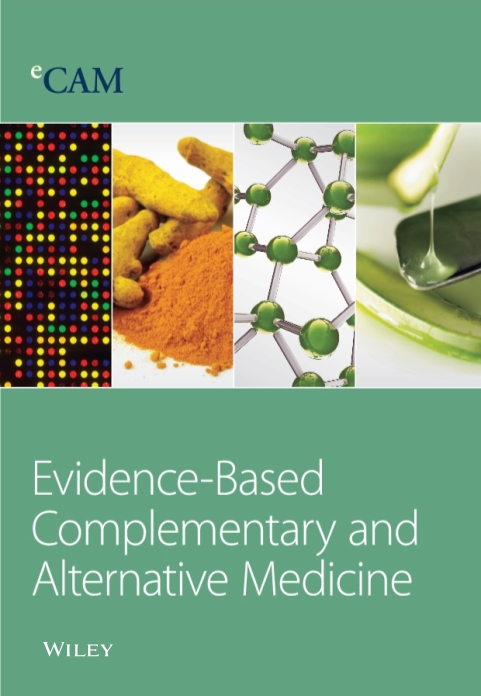鱼腥草通过药理抑制整合素 αⅡbβ3、MAPK 和 PI3K/AKT 通路及氯化铁诱导的小鼠血栓形成,发挥抗血小板和抗血栓形成作用
4区 医学
Q2 Medicine
Evidence-based Complementary and Alternative Medicine
Pub Date : 2024-02-09
DOI:10.1155/2024/9927160
引用次数: 0
摘要
心血管疾病(CVDs)是全球死亡的主要原因。Lespedeza cuneata简称L. cuneata,权威名称为Dumont de Courset (G. Don),是一种多年生开花植物,通常生长在韩国、日本、中国和台湾等亚洲国家。由于 GC-MS 分析表明楔形草提取物含有短链脂肪酸,而据报道短链脂肪酸具有有益心血管的作用,因此我们旨在研究楔形草提取物的抗血小板和抗血栓特性。L. cuneata 的提取物有水、50% EtOH、70% EtOH 和 100% EtOH 四种。在体外抗血小板分析中,制备洗净的血小板,在 1 mM CaCl2 的存在下,用 200 μg/mL 的 50% EtOH 与楔形叶培养 1 分钟,然后在光透射聚集仪上用激动剂(胶原 2.5 μg/mL 或 ADP 10 μM 或凝血酶 0.1 U/mL)刺激 5 分钟。扫描电子显微镜评估血小板形状的变化。通过量化 ATP 释放和细胞内钙动员来评估颗粒含量。纤维蛋白原结合试验和血块回缩试验评估了整合素αⅡbβ3介导的由内向外和由外向内的信号传导。蛋白磷酸化表达则通过 Western 印迹分析进行研究。最后,通过口服楔形叶桉叶 200 和 400 毫克/千克以及阿司匹林 100 毫克/千克,连续 7 天,并进行尾部出血和氯化铁诱导的小鼠血栓模型试验,研究其体内抗血栓功效。楔形叶对体外血小板聚集和血小板形状变化有剂量依赖性抑制作用。钙动员、致密颗粒分泌、整合素 αIIbβ3 介导的由内向外和由外向内信号传导以及 MAPK 和 PI3K/Akt 通路的蛋白磷酸化均受到显著抑制。体内试验显示,楔叶桉树通过非显著性地延长出血时间、改善冠状动脉血流量和动物存活率来防止合成药物的副作用。我们的研究结果表明,楔形叶具有强效的抗血小板和抗血栓作用,可被视为一种具有心脏保护作用的潜在草药。本文章由计算机程序翻译,如有差异,请以英文原文为准。
Antiplatelet and Antithrombotic Activities of Lespedeza cuneata via Pharmacological Inhibition of Integrin αIIbβ3, MAPK, and PI3K/AKT Pathways and FeCl3-Induced Murine Thrombosis
Cardiovascular diseases (CVDs) have been the major cause of mortality all around the globe. Lespedeza cuneata abbreviated as L. cuneata with the authority name of Dumont de Courset (G. Don) is a perennial flowering plant commonly grown in Asian countries such as Korea, Japan, China, and Taiwan. We aimed to investigate the L. cuneata extract’s antiplatelet and antithrombotic properties as GC-MS analysis indicated that the extract contained short-chain fatty acids, which have been reported to possess beneficial cardiovascular effects. L. cuneata was extracted using water, 50% EtOH, 70% EtOH, and 100% EtOH. For in vitro antiplatelet analysis, washed platelets were prepared and incubated with L. cuneata with 200 μg/mL of 50% EtOH in the presence of 1 mM of CaCl2 for 1 minute followed by agonist (collagen 2.5 μg/mL or ADP 10 μM or thrombin 0.1 U/mL) stimulation for 5 minutes over light transmission aggregometer. Scanning electron microscopy was performed to assess platelet shape change. ATP release and intracellular calcium mobilization were quantified to assess the granular content. Fibrinogen-binding assay and clot retraction assay assessed integrin αIIbβ3-mediated inside-out and outside-in signaling. Protein phosphorylation expression was investigated by western blot analysis. Finally, the in vivo antithrombotic efficacy was investigated by oral dosage of L. cuneata 200 and 400 mg/kg and aspirin 100 mg/kg for 7 days, and tail bleeding and FeCl3-induced murine thrombus model were performed. In vitro platelet aggregation and platelet shape change were dose-dependently suppressed by L. cuneata. Calcium mobilization, dense granules secretion, integrin αIIbβ3-mediated inside-out and outside-in signaling, and protein phosphorylation of MAPK and PI3K/Akt pathways were significantly inhibited. In vivo assays revealed that L. cuneata prevents side effects of synthetic drugs via nonsignificantly increasing bleeding time and improving coronary artery blood flow and animal survival. Our results demonstrate that L. cuneata exhibited potent antiplatelet and antithrombotic effects and can be considered a potential herbal medicine with cardioprotective effects.
求助全文
通过发布文献求助,成功后即可免费获取论文全文。
去求助
来源期刊
自引率
0.00%
发文量
1983
审稿时长
2.2 months
期刊介绍:
Evidence-Based Complementary and Alternative Medicine (eCAM) is an international, peer-reviewed journal that seeks to understand the sources and to encourage rigorous research in this new, yet ancient world of complementary and alternative medicine.
The journal seeks to apply scientific rigor to the study of complementary and alternative medicine (CAM) modalities, particularly traditional Asian healing systems. eCAM emphasizes health outcome, while documenting biological mechanisms of action. The journal is devoted to the advancement of science in the field of basic research, clinical studies, methodology or scientific theory in diverse areas of Biomedical Sciences. The journal does not consider articles on homeopathy.

 求助内容:
求助内容: 应助结果提醒方式:
应助结果提醒方式:


